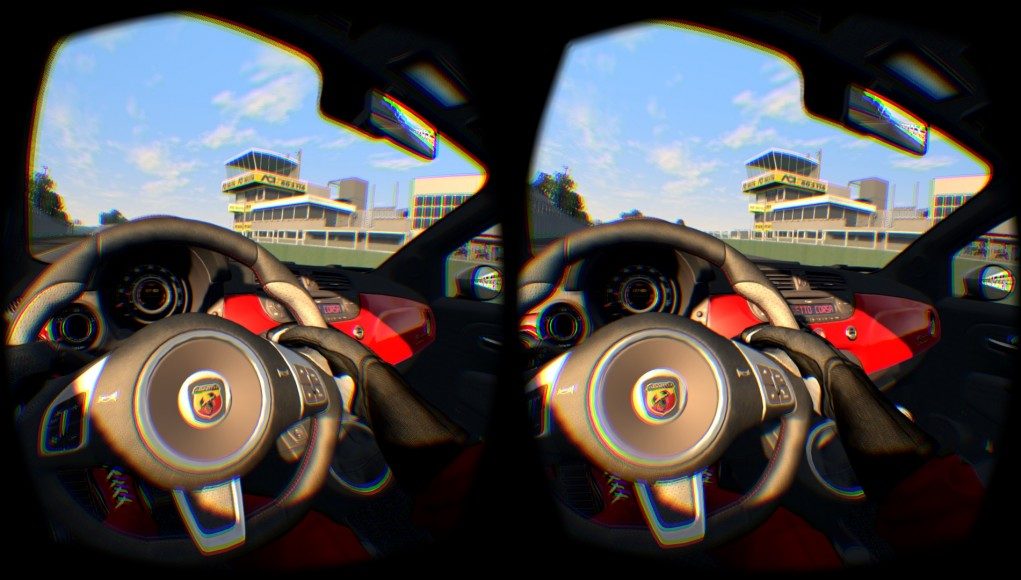 Oculus have prescribed that for this generation of its VR headsets, the target experience is resolutely a seated one. This means that racing games are a match made in heaven for the DK2. And, after a period of drought for VR racers, Kunos Simulazioni’s visually sumptuous racer Assetto Corsa was recently updated to RC1 and with it came Oculus Rift DK2 support.
Oculus have prescribed that for this generation of its VR headsets, the target experience is resolutely a seated one. This means that racing games are a match made in heaven for the DK2. And, after a period of drought for VR racers, Kunos Simulazioni’s visually sumptuous racer Assetto Corsa was recently updated to RC1 and with it came Oculus Rift DK2 support.
VR-oooom!
Racing enthusiasts are one demographic of gaming capable of taking their hobby to extremes to achieve realism and an immersive driving experience. Custom racing seats with triple monitors, and force feedback wheels are not uncommon setups among the dedicated, willing to spend to chase that dream. So it’s intriguing to think that a single virtual reality headset might be enough to trump all of that.
See Also: Racing with the Oculus Rift and a $60,000 Racing Simulator
The problem is, with no commercial release of the Oculus Rift yet announced, companies producing triple-A titles with VR support are hedging their bets in terms of developer time allocation. Assetto Corsa is another title which clearly seems to have struggled diverting enough time to support for VR headset users, but when Assetto Corsa gets it right, it’s a flawed revelation!
Assetto Corsa DK2 Support Disappoints then Astounds
It’s been some time since we sat down with a very early version of Assetto Corsa on the DK1. It was incredibly rough around the edges, but even then I had a hard time concentrating on the track, so powerful was the VR effect and my tendency to be distracted by the grandness of the scenery. And now, with the latest RC1 update, the game now sports Oculus Rift DK2 support.
Given the extensive wait since the last major release of the game and the early promise of Oculus Rift support to those supporting the Steam Early Access version, it’s fair to say that Assetto Corsa’s DK2 support was initially a huge disappointment. The first RC1 release was broken for the DK2 in just about every way. Poor scale, incorrect FOV and lacking 3D / stereoscopy, it had the VR community sharpening pitchforks.
Thankfully, soon after, the release was swiftly patched fixing most of the issues above, bar one fairly major one—no VR menu support. Now, this is something Rift early adopters are becoming accustomed to; it’s our cross to bear for being on the cutting edge to some extent. However, Assetto Corsa’s menus seem to have been unknowingly designed to be utterly incomprehensible and tortuous when peering sideways into your DK2. It’s fair to say then that getting in to play the game with Oculus Rift mode enabled is painful.
However, if you’re willing to persevere and hit the correct menu items in the correct order, you’re dropped into a VR experience that’s nearly flawless. Initially I found myself in the seat of a Fiat 500 Abarth. The first thing that struck me was how damn small the car was, which of course Fiat 500s are in real life—a good example of VR’s strength at conveying scale. Glancing around, Assetto Corsa’s lavish attention to in-car detail is impressive. Stitched leather, textured plastics and even the reflection of your dash in the windshield, all lovingly rendered in glorious stereoscopic 3D.
Looking up and leaning forward into the steering wheel I can confirm positional tracking is spot on. Peering in further to look at the instrument cluster occupied a few too many seconds more than I’d care to admit. When I finally got around to looking through the windows I realised the world glided past my eyes in beautifully smooth low-persistence. Despite the detail on show, my PC had no issues maintaining a rock solid 75FPS, which meant a judder-free experience for the most part.
My first jarring realisation of a flaw was noticing that all mirrors were rendered merely as 2D projected textures with no depth or parallax. It’s something I’d imagine is a tough rendering issue to solve or at the very least a potential performance sapping exercise. Unfortunately, in VR, these seemingly small details break immersion and now that we have positional tracking in the DK2, the lack of correct parallax distracts. That said, it works and works well for the most part.
That niggle aside, racing itself in Assetto Corsa is a fantastic experience when in VR. Pulling away from the starting line and jostling for position amongst a pack of rivals can be an unnerving feeling. The proximity of other motors on the road is felt much more readily in VR. Where in standard 2D, you might play careless, barging cars from the road, you feel much more pressured to keep your distance when immersed.
Once out on the open road, virtual reality’s genuine benefits come to the fore. Approaching and tackling corners is a naturalistic affair, as you speed round, tracking the apex of corners intuitively as you go. It’s something you don’t even think about, because that’s what you’d do in real life, which is why it’s so effective at helping you forget you’re in a game. In fact, after spending some time with this game, I suspect I’ll struggle to return to standard 2D racers with no head tracking.
Switching camera modes away from the cockpit to chase-cam and you feel like you’ve been ejected through the sunroof! You suddenly feel the free space around you as you peer down at your car. It’s surprisingly effective and fun. The apex peering again is very effective in this mode. Next up, windshield cam, a mode in which I found I could easily judge distances and speed although the camera’s position was a little disconcerting—as if your body was lodged in the car with your head crashed through the windshield. Finally, an elevated bumper cam gives the greatest rush of speed. The surprise? All of these are entirely workable in VR.
There is an issue however. The biggest complaint I have about playing Assetto Corsa on the Oculus Rift DK2 is nothing whatsoever to do with the software itself, but the limitation of the DK2’s panel. In racing, you’re constantly hunting the horizon for information on upcoming corners or distant cars. Even though Oculus’ 2nd generation development kit headset is vastly improved in terms of resolution compared to its predecessor, it just doesn’t pack enough pixels to make gazing into the distance anything other than a jumble of dots. That’s not to say Assetto Corsa is unplayable on the Rift, far from it. It merely serves as a reminder that we’ll have to wait until the first consumer edition of the Rift to alleviate the issue.
Recommended?
Do I recommend DK2 owners rushing out to download this game? This is a tough call, so I’m going to chicken out on making it to some extent. If you’re happy with tinkering and a generally frustrating front-end experience, rewarded finally with some sublime VR visuals, you should grab a copy now. If any of what I describe above fills you with fear and/or anger then I’d suggest waiting until VR menu support finally appears (if indeed it ever does).
You can grab Assetto Corsa on Steam right here and find more about it at the game’s website here. We’ll keep pace with the game’s continuing development, and let you know how things progress.












